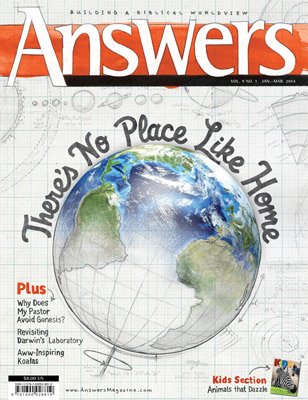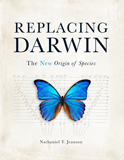
Revisiting Darwin’s Laboratory
Barren lava fields, water-loving reptiles, one-of-a-kind birds—the Galápagos Islands are a scientist’s dream come true. A lab to test your ideas. When Darwin arrived, he saw evolution. But when you start with the Bible, you’ll see the Creator everywhere.
An aura of mystery surrounds the Galápagos Islands, located off South America’s coast in the Pacific Ocean. How were they formed? Why are so many species of animals found only on these islands? Why do they play such a prominent role in the debate over origins?
Over the years, scientists and theologians alike have visited this archipelago, seeking to find answers to these questions. The most famous visitor was Charles Darwin, a naturalist aboard the ship HMS Beagle in 1835.
The striking differences he saw among living creatures on the islands—tortoises with unique shell shapes, finches with a variety of beaks, iguanas with peculiar eating behaviors—were among the influences that eventually led Darwin to propose that all living things descended from a common ancestor over millions of years. He believed that the small differences in living creatures that he observed could, over time, result in large differences that would change one kind of organism into a different organism.
In 2011, 176 years after Darwin’s visit, I had the opportunity to travel to the Galápagos Islands as a lecturer and researcher. Although I observed the same astounding variety among the island’s inhabitants, I came to very different conclusions. Why?
Same Islands, Different Starting Points
Darwin and I came to the islands with different worldviews, and that colored everything we saw.
When Darwin visited the islands, he was impacted by the views of geologist, Charles Lyell, who believed that the history of the Old Testament was false and the earth was millions of years old. This worldview provided an important foundation for Darwin’s development of evolutionary ideas.
Although Darwin and I observed similar landscapes and animals, we interpreted the evidence differently due to our different worldviews.
When I arrived, I began with a completely different worldview. I believe that the Bible is true. According to Genesis, God created in six 24-hour days (Genesis 1); and based on Scripture, this occurred approximately 6,000 years ago. God created organisms “according to their kind” on the third, fifth, and sixth days (Genesis 1:11–13, 1:20–25). That would have included the kinds that tortoises, finches, and iguanas are members of. By inference every kind was designed from the very beginning to reproduce more of the same kind (commonly at the family level in the modern classification scheme).
Later, as the Flood reshaped the face of the earth, including newly formed islands, these various animal kinds spread out and adapted to their new habitats (see “Hawaii’s Volcanic Origins—Instant Paradise,” p. 56).
With such different starting beliefs, my conclusions about the Galápagos Islands’ history were bound to differ from Darwin’s. We didn’t differ in our basic observations, only our reconstruction of past events, which neither of us could observe.
Understanding when the Galápagos Islands rose out of the ocean and how animals and plants got there and changed over time falls into the category of historical science. Historical science encompasses the unobservable, unrepeatable, untestable past and is highly dependent on a person’s worldview. In contrast, observational science deals with the “here and now.” It can be observed, tested, and repeated and so is not as dependent on a person’s worldview.
Both Darwin and I would agree on observational science. Our main difference is the starting point for evaluating history. Do we base our historical science on man’s ideas, or do we base it on the eyewitness account of the Creator God recorded for us in Scripture?
What Can We Observe Today?

photo: Dreamstime.com
We observed Darwin's finches, which are often showcased as an "icon of evolution."
Using observational science, we can see how volcanic activity quickly forms new islands and is changing existing islands today. Catastrophic events like volcanic eruptions can change an island’s landscape in a short period of time. Millions of years are not required. Creation geologists believe that these volcanic islands arose in the years after the Flood, and some are more recent than others.
Mutations, natural selection, and other biological mechanisms have never been observed to change animals and plants from one kind into completely different kinds. We find tortoises, finches, and iguanas existing on nearby continents. We can easily imagine how they may have moved from the continents to the islands, but evolution from a single common ancestor has never been observed. Observational science confirms God’s Word! Animals change slightly to suit new environments, but these changes always remain within recognizable kinds.
Old and New Landscapes
The landscape and wildlife of the Galápagos have a lot to teach us, if we begin with the right starting point (Job 12:7–9). They display both the majesty of God’s creation and His mercy in preserving life in a world cursed as a result of Adam’s Fall. Consider just a small sample of the beauty of these islands and the lessons we learn about God’s design for creatures to refill the earth after the Flood (Genesis 8:17).

photo: Dreamstime.com
On some islands, large lava fields displayed the beautiful rope shapes from pahoehoe lava flows.
When I visited the Galápagos, I was amazed at the great diversity of landscapes. We could easily tell which islands have been around a long time (likely arising soon after the Flood)—we tramped through lush vegetation on the oldest islands like Española and Floreana, which have had plenty of time to be fully populated. Meanwhile, lava fields on the youngest islands—volcanically generated over the last few hundred years—were nearly barren.
On Isabela and Fernandina (the youngest islands) we viewed several prominent and still-active volcanoes. On Bartolomé, another recent island, the landscape was dotted with numerous parasitic cones (the result of volcanic side eruptions). The combination of looming volcanoes, parasitic cones, and large black lava fields made us feel as if we were on another planet!
On Santiago we hiked across a huge lava field, the result of an eruption just over a hundred years ago. The lava flowed for three months and was 7 feet (2.1 m) deep. Today, the field covers 15 square miles (38.8 km2). Clearly volcanoes can produce rapid changes.
But even amid the seeming harshness of this landscape, we observed beauty and life. The pahoehoe lava formed beautiful shapes as it flowed as smooth ropes. Even on young islands, pioneer plants like mollugo, tiquilia, and lava cacti had managed to conquer the bleak landscape.

photos: Thinkstock.com
Barren lava fields on younger islands contrast with the lush vegetation of older islands like Floreana.
Change Within Kinds
Beautiful and varied as they are, the volcanic landscapes are not what draw millions of visitors to these islands. It’s the wildlife. And we were not disappointed.
One observation that especially intrigues Bible-believing Christians is the predominance of specialized species that thrive in this region but nowhere else. We were able to watch many of these species firsthand.
Since I start with the historical facts of God’s Word, I arrive at far different conclusions than Darwin did. It is clear that the Galápagos creatures have beautiful designs that suit them well for their environment. Many of these designs are far too integrated to have arisen by chance mutations. Their designs point, instead, to the clear handiwork of a Designer (Romans 1:19–20).
Rather than assuming these designs arose randomly over millions of years, creation biologists know from Scripture that these variations must have appeared relatively quickly, within only a few thousand years after the Flood.
Blue-Footed Boobies
A highlight of the trip was an amazing aerial display by the blue-footed boobies. As we came around a corner off the coast of Santa Cruz, we saw hundreds of blue-footed boobies floating in the water. Within moments, as if responding to some unknown signal, they all took flight and flew a short circle in the air; then the whole group dive-bombed back into the water to capture their prey.

photo: Nature Picture Library
One highlight of our trip was watching hundreds of blue-footed boobies dive-bomb into the water at speeds of nearly 60 miles per hour to capture their prey.
Blue-footed boobies hit the water at 60 miles per hour (96.6 km/h), yet God has designed their heads and bodies to withstand the force of this impact. Seeing so many of them diving at once was truly incredible, leaving us without any doubt about their Designer. No trial and error could lead to these designs! (See “Northern Gannets—Death-Defying Dive Bombers,” p. 46, for details about the incredible designs required for this unique behavior.)
Marine Iguanas
We had to be careful on many of the islands not to step on the marine iguanas—they’re so numerous and nearly invisible against the black lava rocks on which they warm themselves. The Galápagos iguanas are the only iguanas in the world that feed in the water, very atypical for a cold-blooded reptile. The water can be relatively cold because of currents originating from the Antarctic. This is hardly an environment where reptiles could adapt slowly—they’d die first.

photos: Thinkstock.com
Marine iguanas seem to have all the designs they need to excel in this unique environment.
These marine iguanas have long, sharp claws to grip the rocks, preventing them from being swept away by the current as they feed on algae in the ocean. In fact, they seem to have all the designs they need to excel in this strange environment (barren islands straddling the equator, surrounded by frigid currents and a food-rich ocean).
The original iguana ancestors that colonized the islands may have eaten only on land. Certain adaptive traits may then have become expressed through a process called mediated design. The Creator could easily program all these special designs into the original DNA, waiting for the right conditions to be expressed to allow a new generation of iguanas to take advantage of ocean food.
Sort of like a Swiss army knife, the original created creatures possessed all the necessary designs to help them overcome challenges that would arise in the future, such as the harsh conditions after the Flood. (For more on mediated design, see the new book Galápagos Islands—A Different View.)
Galápagos Giant Tortoises

photo: Dreamstime.com
The Galápagos giant tortoise can grow to be over 500 pounds.
The islands also host the largest tortoises on earth, which can grow to be over 500 pounds (227 kg) and eat almost nonstop to maintain their enormous body weight. Giant tortoises flourished on the islands, at least until the arrival of humans. Unfortunately, feral animals (creatures introduced by humans and gone wild), such as goats and pigs, have made it nearly impossible for tortoises to successfully lay eggs and survive without human intervention.
On Santa Cruz, we visited the Charles Darwin Research Station and got a glimpse of the tortoise breeding program, which helps reintroduce and maintain these magnificent creatures on the islands.
Flightless Cormorants

photos: Thinkstock.com
On Fernandina Island lives the only species of flightless cormorant in the world.
On Fernandina I especially enjoyed watching the duck-like actions of the only species of flightless cormorant in the world. Their wings are small and stubby, only about a third of the size needed to fly. While this looks awkward, the birds are incredibly adept at swimming underwater and catching prey. Their survival proves the effectiveness of this body design.
Since food is abundant in the ocean and the islands are free of natural predators, the adaptive trait of flightlessness may have become expressed through mediated design—the same process behind the specialized traits of marine iguanas.
Darwin’s Finches
On several of the islands we also observed the so-called Darwin’s finches, which are often showcased as an “icon of evolution.” While the average beak size in a given finch population is observed to increase or decrease over time, the beaks never become anything other than beaks, and the finch nothing other than a finch! This variation appears to be a beautiful design within their genetic makeup. Different beak sizes become dominant within populations—as a result of natural selection—during years of drought and plenty, enabling them to reach different types of seeds that vary in availability.
Completely different genetic mechanisms would be required to produce directional changes, leading one kind of animal to evolve into a different kind of animal. Varying beak sizes is not the same as converting a four-footed beast into a bird. Nothing like that has ever been observed, and no genetic mechanism exists that would allow this type of change to occur.
Great Expectations
Although Darwin and I observed similar landscapes and animals, we interpreted the evidence differently due to our different worldviews. Darwin believed man’s ideas about the unobservable past were correct. I believe that the eyewitness account of God recorded in Genesis—the inerrant Word of God—is correct.
As many others have discovered, observational science is consistent with and confirms God’s Word. But it is inconsistent with and does not confirm evolutionary ideas, including millions of years. Although we don’t need anything outside of Scripture to prove its truthfulness, we expect our observations in the world to be consistent with God’s Word . . . and they are.
Related Downloads
Galapagos Islands: A Different View Excerpt
PDF DownloadAnswers Magazine
January – March 2014
Placed safely in our solar system’s “goldilocks zone” and engineered with the perfect balance of atmosphere, chemicals, and water, our earth was miraculously formed to be inhabited (Isaiah 45:18). This issue examines the earth’s unique suitability for life. We’ll also investigate what seminaries are actually teaching our pastors, the possibility that viruses could be beneficial, and more.
Browse Issue SubscribeRecommended Resources

Answers in Genesis is an apologetics ministry, dedicated to helping Christians defend their faith and proclaim the good news of Jesus Christ.
- Customer Service 800.778.3390
- © 2024 Answers in Genesis










